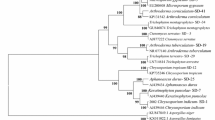Abstract
Diversity of keratinophilic mycoflora in the soil of Agra was under observation for 1 year (July 2001–June 2002) and isolation of keratinophilic fungi was followed by the hair-baiting method. The frequency of occurrence of keratinophilic fungi in 284 soil samples collected from various hospitals, cattle yards, poultry farms, crop fields and play grounds was determined, 204 samples (72 %) having been found to be positive. A total of 33 species classified into 11 genera (Acremonium, Aspergillus, Chrysosporium, Emmonsia, Geomyces, Keratinophyton, Microsporum, Myceliophthora, Penicillium, Sporotrichum, Trichophyton) were encountered from the soil samples.Sporotrichum spp. were found to be the most dominant species followed byTrichophyton simii. The parameter of keratinophilic fungi found in the samples studied ranged from 62 to 80 % where playgrounds yielded the maximum number of species (80 %) while the least dominating soil was hospital soil (62 %). Among all the baits used maximum fungi occurred on human hairs (82 %) followed by chicken feather (74 %), wool (61 %) and the least on horns (45 %). The spectrum of keratinophilic fungi isolated from different sites differed considerably according to the frequency of use by humans.
Similar content being viewed by others
References
Ajello L.: Geographical distribution and prevalence of the dermatophytes.Ann.N.Y.Acad.Sci. 89, 30–38 (1960).
Benedek T.: Fragmenta mycological I. Some historical remarks on the development of “hair-baiting” of Toma-Karling-Vanbreuseghem (the To-Ka-Va hair-baiting method).Mycopathol.Mycol.Appl. 16, 104–106 (1962).
Buchniček J.: Die Ultrastruktur der Apikalzellen beiMicrosporum gypseum nach Wachstumshemmung durch ultraviolettes Licht.Mykosen 24, 472–481 (1981).
Carmichael J.W.:Chrysosporium and some other aleuriosporic hyphomycetes.Can.J.Bot. 40, 1137–1173 (1962).
Chalupová V., Raclavský V., Novotný R.: Rylux BSU stimulates spore germination inTrichophyton mentagrophytes andAspergillus fumigatus and increases the survival rate after UV-irradiation.Folia Microbiol. 47, 152–156 (2002).
Chmel L., Hasilikova A., Hrasko J., Vlacilikova A.: The influence of some ecological factors on keratinophilic fungi in the soil.Sabourandia 10, 26–34 (1972).
Deshmukh S.K.: Morphological and physiological studies of some keratinophilic fungi from soils of Madhya Pradesh (India).PhD Thesis. University of Sagar, Sagar, Madhya Pradesh (India) 1982.
Deshmukh S.K., Agarwal S.C.: Prevalence of dermatophytes and other keratinophilic fungi in soil of Madhya Pradesh (India).Mykosen 26, 574–577 (1983).
Dey N.C., Kakoti L.M.:Microsporum gypseum in India.J.Indian Med.Assoc. 25, 160–164 (1955).
Dixit A.K., Kushwaha R.K.S.: Keratinophilic fungi of Andaman Island, India.J.Microbiol. 30, 349–350 (1990).
Efuntoye M.O., Fashanu S.O.: Occurrence of keratinophilic fungi and dermatophytes on domestic birds in Nigeria.Mycopathologia 153, 87–89 (2001).
Frey D., Oldfield R.J., Bridger R.C.:A Colour Atlas of Pathogenic Fungi. Wolfe Medical Publication Ltd., London 1986.
Garg A.K.: Isolation of dermatophytes and other keratinophilic fungi from soils in India.Sabouraudia 4, 259–264 (1966).
Garg A.P., Gandotra S., Mukerji K.G., Pugh G.J.F.: Ecology of keratinophilic fungi.Proc.Indian Acad.Sci.(Plant Sci.) 94, 149–163 (1985).
Govil N., Bhatnagar V.P., Kumar A., Mathur M., Shrivastava J.N.: Biodiversity of keratinophiles isolated in Indian hills (Simla, H.P.) and plain (Agra, U.P.).J.Indian Bot.Soc. 80, 183–186 (2001).
Khanam S.J.P., Jain P.C.: Isolation of keratin degrading fungi from soil of Damoh, India.Asian J.Microbiol.Biotechnol.Environ.Sci. 4, 251–254 (2002).
Kushwaha R.K.S., Agarwal S.C.: Some keratinophilic fungi and related dermatophytes from soil.Proc.Indian Nat.Sci.Acad. 42, 102–110 (1976).
Mercantini R., Marsella R., Lambiase L., Belardi M.: Isolation of keratinophilic fungi from floors in Roman kindergarden and secondary schools.Mycopathologia 94, 109–115 (1986).
Ogbonna C.I.C., Pugh G.J.F.: Keratinophic fungi from Nigerian soil.Mycopathologia 99, 115–118 (1987).
Padhye A.A., Misra S.P., Thirumalachar M.J.: Occurrence of soil inhabiting dermatophytes and other keratinophilic fungi from soils in Poona.Hind.Antibiot.Bull. 9, 90–93 (1966).
Randhawa H.S., Sandhu R.S.: A survey of soil inhabiting dermatophytes and related keratinophilic fungi of India.Sabouraudia 4, 71–79 (1965).
Saxena R.P., Buruah P.: Keratinophilic fungi in soil.J.Indian Bot.Soc. 61, 80–84 (1982).
Sharma B., Nawange S., Pandey A., Singh S.M.: Examination of soils from residual garbage in Betul, India, for fungi by the keratin baiting technique.Zbl.Bakteriol. 286, 139–145 (1997).
Shrivastava J.N.: Studies on soil inhabiting dermatophytes and keratinophilic fungi.PhD Thesis. Kanpur University, Kanpur (India) 1985.
Singh B.S., Singh D.V., Singh B.G., Sinha R.J.: Incidence of keratinophilic fungi and related dermatophytes in Agra soil.Adv.Plant Sci. 3, 8–15 (1990).
Singh C.J., Singh B.G., Singh B.S.: Keratinophilic fungi of Ghana birds sanctuary, Bharatpur, Rajasthan (India).Adv.Plant Sci. 7, 280–291 (1994).
Soon S.H.T.: Isolation of keratinophilic fungi from soil in Malaysia.Mycopathologia 113, 155–158 (1991).
Sunderam B.M.: Incidence of keratinophilic fungi in rice field soil.Mycopathologia 97, 43–44 (1987).
Van Oorschot C.A.N.: A revision ofChrysosporium and allied genera.Stud.Mycol. 20, 1–89 (1980).
Vanbreuseghem R.: Keratin digestion by dermatophytes: a specific diagnostic method.Mycologia 44, 176–182 (1952).
Vanbreuseghem R.: Geographical distribution of dermatophytes.Internat.J.Dermatol. 9, 102–109 (1970).
Youssef Y.A., El Din A.A.K., Hassanein S.M.: Occurrence of keratinolytic fungi in soils in Cairo, Egypt.Zbl.Mikrobiol. 147, 80–84 (1992).
Author information
Authors and Affiliations
Additional information
The authors are highly obliged to Prof. R.K.S. Kushwaha (Department of Botany, Christ Church College, Kanpur, India) for valuable comments.
Rights and permissions
About this article
Cite this article
Saxena, P., Kumar, A. & Shrivastava, J.N. Diversity of keratinophilic mycoflora in the soil of Agra (India). Folia Microbiol 49, 430–434 (2004). https://doi.org/10.1007/BF02931605
Received:
Revised:
Published:
Issue Date:
DOI: https://doi.org/10.1007/BF02931605




